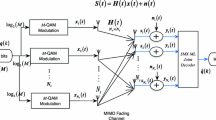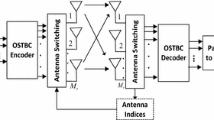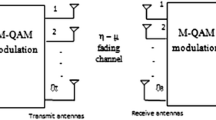Abstract
Novel general performance analysis of various multiple-input multiple-output (MIMO) systems over Hoyt distribution fading channel is presented and discussed in this study. Hoyt distribution, called sometimes Nakagami-q, spans over other distributions ranging from one-sided Gaussian (\(q=0\)) to Rayleigh fading (\(q=1\)). Hoyt channel describes short-term signal variation of certain wireless communications systems, as in satellite links with strong ionospheric scintillation. Average bit error rate analysis of space shift keying (SSK), quadrature spatial modulation (QSM) and spatial multiplexing (SMX) MIMO systems over Hoyt channel is evaluated and studied in this paper. As well, the generation of accurate joint phase and envelope statistics of the MIMO Hoyt channel is conferred and discoursed. It is reported that marginal performance degradation occurs when decreasing the Hoyt q function from \(1\rightarrow 0.5\). Whereas, substantial performance losses are noticed for all considered MIMO systems when \(q<0.5\). Derived analytical and asymptotic results are corroborated with Monte Carlo simulation results, where close match is reported for wide range of system and channel parameters.









Similar content being viewed by others
References
Cisco Visual Networking Index, Cisco Visual Networking Index: Global Mobile Data Traffic Forecast Update, 2017-2022 , Feb. 2019.
Chen, S., Sun, S., Xu, G., Su, X., & Cai, Y. (2020). Beam-space multiplexing: Practice, theory, and trends, from 4G TD-LTE, 5G, to 6G and beyond. IEEE Wireless Communications, 27(2), 162–172.
Serghiou, D., Khalily, M., Singh, V., Araghi, A., & Tafazolli, R. (2020). Sub-6 GHz dual-band \(8 \times 8\) MIMO antenna for 5G smartphones. IEEE Antennas and Wireless Propagation Letters, 19(9), 1546–1550.
Akyildiz, I. F., Kak, A., & Nie, S. (2020). 6G and beyond: The future of wireless communications systems. IEEE Access, 8, 133.
Basar, E. (2020). Reconfigurable intelligent surface-based index modulation: A new beyond MIMO paradigm for 6G. IEEE Transactions on Communications, 68(5), 3187–3196.
Chytil, B. (1967). The distribution of amplitude scintillation and the conversion of scintillation indices. Journal of Atmospheric and Terrestrial Physics, 29, 1175–1177.
Bischoff, K., & Chytil, B. (1969). A note on scintillation indices. Planet Space Science, 17, 1059–1066.
Simon, M. K., & Alouini, M. (2005). Digital communication over fading channels. Hoboken: Wiley series in telecommunications and signal processing Wiley.
Liu, X. (2011). Optimization of satellite laser communication subject to log-square-hoyt fading. IEEE Transactions on Aerospace and Electronic Systems, 47(4), 3007–3012.
Liu, X. (2012). Amount of log-square-hoyt fading in satellite optical communications. IEEE Communications Letters, 16(5), 666–669.
Wu, C., Yi, X., Zhu, Y., Wang, W., You, L., & Gao, X. (2021). Channel prediction in high-mobility massive MIMO: from spatio-temporal autoregression to deep learning. IEEE Journal on Selected Areas in Communications, 39(7), 1915–1930.
Ma, Z., et al. (2020). Impact of UAV rotation on MIMO channel characterization for air-to-ground communication systems. IEEE Transactions on Vehicular Technology, 69(11), 12.
Zhu, Q., et al. (2018). A novel 3D non-stationary wireless MIMO channel simulator and hardware emulator. IEEE Transactions on Communications, 66(9), 3865–3878.
Avazov, N., et al. (2021). A trajectory-driven 3D non-stationary mm-Wave MIMO channel model for a single moving point scatterer. IEEE Access, 9, 115.
Zhu, Q., Jiang, K., Chen, X., Zhong, W., & Yang, Y. (2018). A novel 3D non-stationary UAV-MIMO channel model and its statistical properties. China Communications, 15(12), 147–158.
Basar, E., Wen, M., Mesleh, R., Di Renzo, M., Xiao, Y., & Haas, H. (2017). Index Modulation Techniques for Next-Generation Wireless Networks. IEEE Access, 5, 16.
Mesleh, R., & Alhassi, A. (2018). Space modulation techniques. Hoboken: Wiley.
Younis, A., Mesleh, R., & Haas, H. (2015). Quadrature spatial modulation performance over Nakagami–m Fading Channels, IEEE Trans. on Veh. Technol.,
Hedayat, A., Shah, H., & Nosratinia, A. (2005). Analysis of space-time coding in correlated fading channels. IEEE Transaction on Wireless Communication, 4(6), 2882–2891.
Mesleh, R., Badarneh, O. S., Younis, A., & Haas, H. (2015). Performance analysis of spatial modulation and space-shift keying with imperfect channel estimation over generalized \(\eta {-}\mu \) fading channels. IEEE Transactions on Vehicular Technology, 64(1), 88–96.
Di Renzo, M., Haas, H., & Grant, P. M. (2011). Spatial modulation for multiple-antenna wireless systems: A survey. IEEE Communicatioin and Magazine, 49(11), 182–191.
Fraidenraich, G., Leveque, O., & Cioffi, J. M. (2007). On the MIMO channel capacity for the dual and asymptotic cases over Hoyt channels. IEEE Communications Letters, 11(1), 31–33.
Kumar, S., & Pandey, A. (2010). Random matrix model for Nakagami-Hoyt fading. IEEE Transactions on Information Theory, 56(5), 2360–2372.
Ropokis, G. A., Rontogiannis, A. A., & Mathiopoulos, P. T. (2008). Quadratic forms in normal RVs: Theory and applications To OSTBCs Over Hoyt fading channels. IEEE Transactions on Wireless Communications, 7(12), 5009–5019.
Romero-Jerez, J. M., & Lopez-Martinez, F. J. (2017). A new framework for the performance analysis of wireless communications under Hoyt (Nakagami- \(q\) ) fading. IEEE Transactions on Information Theory, 63(3), 1693–1702.
Youssef, N., Wang, C.-X., & Patzold, M. (2005). A study on the second order statistics of Nakagami-Hoyt mobile fading channels. IEEE Transactions on Vehicular Technology, 54(4), 1259–1265.
Badarneh, O. S., & Mesleh, R. (2016). A comprehensive framework for quadrature spatial modulation in generalized fading scenarios. IEEE Transactions on Communication, 64(7), 2961–2970.
Wolniansky, P., Foschini, G., Golden, G., & Valenzuela, R.: V-BLAST: An Architecture for Realizing Very High Data Rates over the Rich-Scattering Wireless Channel, in Unino Radio-Scientifique Internationale (URSI) Intern. Symp. on Signals, Systems, and Electronics (ISSSE), Sep. 29–Oct. 2, 1998, pp. 295–300.
Mesleh, R., Ikki, S., & Aggoune, H. (2015). Quadrature spatial modulation. IEEE Transaction on Vehicular Technology, 64(6), 2738–2742.
Jeganathan, J., Ghrayeb, A., Szczecinski, L., & Ceron, A. (2009). Space shift keying modulation for MIMO channels. IEEE Transaction on Wireless Communication, 8(7), 3692–3703.
Proakis, J. G. (2000). Digital communications (4th ed.). USA: McGraw-Hill.
Turin, G. L. (1960). The characteristic function of Hermitian quadratic forms in complex normal variables. Biometrika, 47(1/2), 199–201.
Author information
Authors and Affiliations
Corresponding author
Additional information
Publisher's Note
Springer Nature remains neutral with regard to jurisdictional claims in published maps and institutional affiliations.
Rights and permissions
About this article
Cite this article
Mesleh, R., Badarneh, O.S. Performance analysis of variant MIMO systems over hoyt fading channel. Wireless Netw 28, 1649–1656 (2022). https://doi.org/10.1007/s11276-022-02930-0
Accepted:
Published:
Issue Date:
DOI: https://doi.org/10.1007/s11276-022-02930-0




